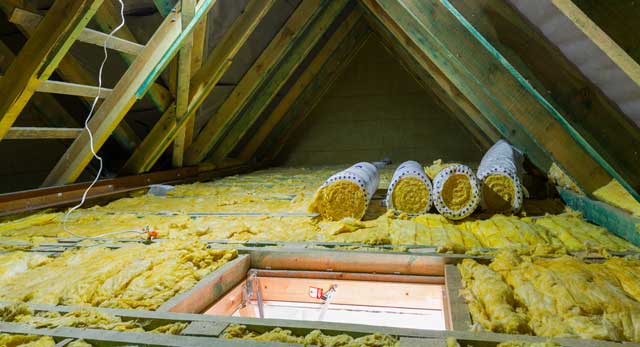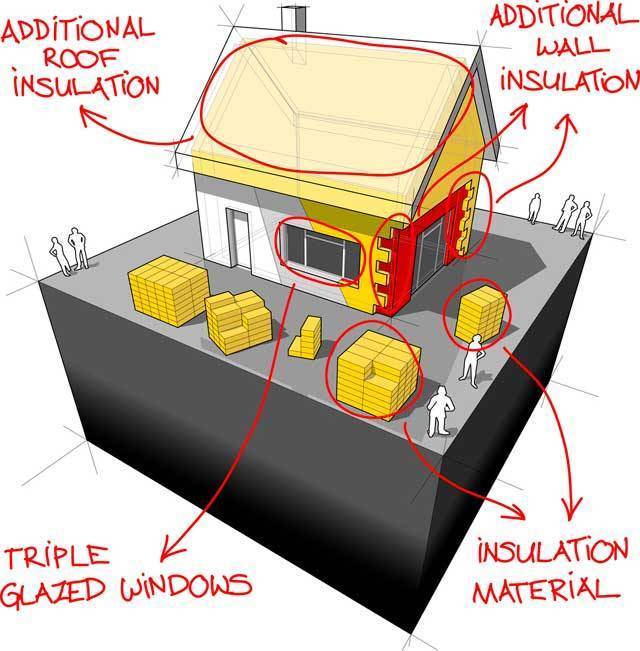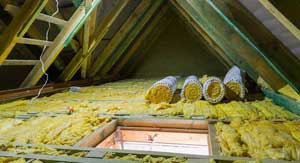If your attic isn’t insulated, a considerable quantity of heat seeps out of your roof, roughly 30% of the heat you’ve already paid for. Loft insulation is a simple process. If your loft isn’t already insulated, the insulating material should cost around on average £275 for an average sized loft. However, once fitted, you’ll save about £200 per year in decreased heating expenditures.
As a result, the project’s cost has already paid for itself in lower energy bills after only 18 months, and you’ll save a considerable amount of money on heating expenditures every year after that. The minimum thickness of loft insulation is 200mm, according to industry standards.

Mineral Fibre or Fibre Glass matting is available in 100mm and 200mm thick rolls, with the thinner 100mm variant being used to cover existing, older, and hence often thinner insulation. This insulation is most commonly utilized by homeowners who are confident in their ability to do the job themselves.
However, extreme caution should be exercised, and the question of whether to install yourself or employ a professional fitter is addressed further down. Loose-fill loft insulation is an option that is utilized if the space between joists is uneven or where roll-based insulation is difficult to access.
UK Department of Energy
According to the UK Department of Energy, heating and cooling account for 49% of a home’s energy cost. Because your home isn’t adequately insulated, your energy expenses may skyrocket throughout the winter (and even in the summer when the air conditioner is turned on).
A well-insulated home will allow you to keep your electric cost in check, and energy-efficient home is also healthier for the environment. So, how can house insulation help you save money on your energy bills? Let’s take a closer look.
During the winter, heating the house might account for the bulk of the utility expenses. As a result, improving the insulation of your home is critical to saving energy and money. Loft insulation is, without a doubt, an effective form of insulation that can be installed to save you heating bills.
One method to help with the rising expense of heating your house in winter is to take advantage of insulation and cavity wall insulation subsidies. People from all walks of life may now apply for these funds when available. The government recognizes the need to reduce carbon emissions, having the country’s lofts insulated, will help with that goal of reducing more than 15%.
Understanding How To Insulate A Loft
However, understanding how to insulate a roof, or at the very least the loft underneath that roof, may prevent a quarter of the heat from escaping from your home to the air outside. That’s how much light gets through, and it’s why the pigeons and seagulls on your roof have a smug look on their faces.
You’re spending a lot of money every day to keep those birds’ rear ends warm and toasty, but the good news is that insulating a loft may save you money, last up to 40 years, and is something you can do yourself. While some may be put off by the cost an attic might cost anywhere from £1,000 to £2,000 or more—the investment should pay off. “It’s the smartest investment I’ve ever made,” says the author. “A well-insulated house will keep you more comfortable in any season.” It’s also a lot quieter.”
According to the EPA, adding insulation to attics, crawl spaces, and basement rim joists may save the typical homeowner 15% on heating and cooling expenditures (or 11% of overall energy expenditure). For most people, it equates to around £200 in annual savings. Savings can reach 20% in colder sections of the nation, such as climatic zones six and seven. With most insulation types costing between £0.20 and £0.50 per square foot, you can do the math to figure out how much money you’ll save over time if you upgrade your home’s insulation.
According to recent research, putting fiberglass insulation in the attic provides at least a break-even return on investment in terms of property value. Additionally, you may be eligible for tax benefits to help finance the update; however, they are subject to change, so it’s best to consult a an accountant for the most up-to-date information.
An energy audit of your house will help you choose where you should focus your insulation upgrades. However, it’s safe to assume that the attic is the place to start in most homes—especially those built before 1960. To protect the living spaces below, you’ll want to put insulation between and above the floor joists.
It would help if you also insulated any external walls, walls between the residence and unheated spaces (such as an attached garage), and floors above unheated areas (such as crawlspaces). Any drafts around windows and door frames, as well as those from your dryer vent or fireplace, should be sealed.
Loft Insulation’s Advantages
- Conserve energy.
Up to 50% of your home’s energy might be lost via the roof if you don’t have enough insulation. As a result, the house becomes colder faster, necessitating more central heating. An insulated loft helps the home stay warmer for longer, reducing energy waste. There is less need for central heating, and more energy is conserved.
- Conserve funds
Saving energy and money are inextricably linked. Your decreased energy expenses will even assist you in paying for the installation.
- Protecting the environment
The more energy used in the household, the more greenhouse gases are released into the atmosphere, leading to global warming and environmental issues. It will help the homeowner save money, but it also benefits the rest of the earth!
- Take advantage of the warmer weather
In the winter, house insulation will keep you warm, but it will keep you cool in the summer. The blanketing material keeps heat from leaving as well as coming in from above. In the winter, sleep warmly, while in the summer, sleep coolly.
- Increase your home’s worth
House insulation provides some positives sale points related to to your home because it has so many benefits in energy, money, and home comfort. Your house’s Energy Performance Certificate rating will improve due to the installation.
Insulation also helps minimize noise levels entering your property from the outside, helps with condensation problems, requires no upkeep, and may last an endless amount of time.
Summer Shortage Of Timber Due To Sweden Lockdown
We have significant respect for our Swedish associates, who have in fact consistently functioned throughout the pandemic to provide UK wood calls for, as they have actually provided for years,
The Benefits Of Loft Insulation
There are a variety of loft insulation alternatives available, and depending on where you reside and other qualifying circumstance
What Is Cavity Wall Insulation
A cavity wall can be found in almost every home built in the United Kingdom after 1920.
An Office Loft Conversion
Some people have loft conversions for the sole purpose of living in them, while others prefer to use them as an office space.
How Loft Insulation Can save Energy Bills
According to the UK Department of Energy, heating and cooling account for 49% of a home's energy cost.
What Is a Composite Door?
Unlike sold timber doors, these modern equivalents do not need painting and most come with a warranty that could last decades
If You Are Unhappy With Any Building Work
If you have issues with a tradesman, whether it's incomplete or sub-standard work in your house, it's helpful to know how to complain and what action you should take to resolve the issue.
Why Do I Need a Completion Certificate For Building Work?
When construction work is reviewed by suitably qualified building control surveyors and a completion certificate is given at the end
PEOPLE OFTEN ASK THEMSELVES – IS IT WORTH MOVING OR STAYING?
Perhaps you need space for a living room, or perhaps your family is expanding and you require an additional bedroom, or maybe you need a large kitchen dining area.









